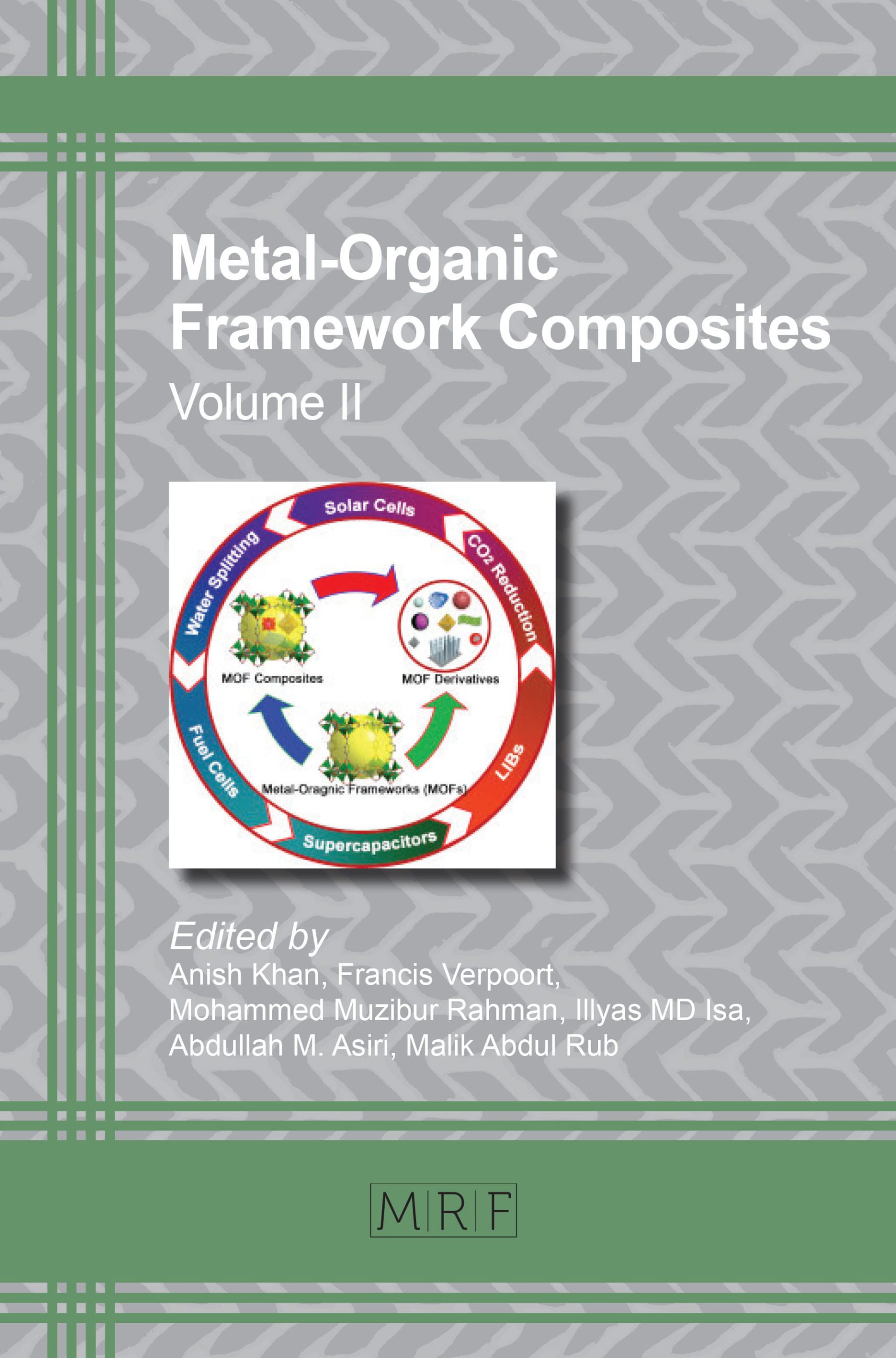Metal Organic Frameworks Based Materials for Renewable Energy Applications
Haydar Göksu, Nursefa Zengin, Fatih Şen
Crystalline metal-organic frames (MOFs) fall into the category of high potential porous materials that can be used in gas storage, adsorption / separation, adsorption as adsorbent, catalysis, magnetism, sensor design and drug delivery. MOFs are typically formed by self-assembly, where secondary building units (SBUs) are connected with organic ligands to form complex networks. Organic ligands or metallic SBUs may be modified to be critical for their functionality and utility for specific applications in order to control the porosity of MOFs. MOFs are used in renewable energy and environmental applications, application of hydrogen energy, hydrogen storage, storage and conversion of CO2, biogas production, thermal energy storage, rechargeable batteries and supercapacitors and in dye sensitized solar cells.
Keywords
Metal Organic Frameworks (MOFs), Renewable Energy, Storage, Hydrogen, Biogas
Published online 10/5/2019, 13 pages
Citation: Haydar Göksu, Nursefa Zengin, Fatih Şen, Metal Organic Frameworks Based Materials for Renewable Energy Applications, Materials Research Foundations, Vol. 58, pp 19-31, 2019
DOI: https://doi.org/10.21741/9781644900437-2
Part of the book on Metal-Organic Framework Composites
References
[1] International Energy Agency (IEA), How The Energy Sector Can Deliver On A Climate Agreement InCopenhagen, October, 2009, p.17
[2] Roemmich, D., Church, J., Gilson, J., Monselesan, D., Sutton, P., Wijffels, S., Unabated planetary warming and its ocean structure since 2006, Nat. Clim. Change, 2015, 5, 240–245. https://doi.org/10.1038/nclimate2513
[3] Boot-Handford, M. E. et al. Carbon capture and storage update, Energy Environ. Sci., 2014, 7, 130–189. https://doi.org/10.1039/C3EE42350F
[4] Sumida, K., Rogow, D. L., Mason, J. A., McDonald, T. M., Bloch, E. D., Herm, Z. R., Bae, T. H., Long, J. R., Carbon dioxide capture in metal-organic frameworks, Chem. Rev., 2012, 112, 724-781. https://doi.org/10.1021/cr2003272
[5] Bai, Y., Dou, Y., Xie, L.-H., Rutledge, W., Li, J.-R., Zhou, H.-C., Zr-based metal-organic frameworks: design, synthesis, structure, and applications, Chem. Soc. Rev., 2016, 45, 2327-2367. https://doi.org/10.1039/C5CS00837A
[6] Yaghi, O. M., O’Keeffe, M., Ockwig, N. W., Chae, H. K., Eddaoudi, M., Kim, J., Reticular synthesis and the design of new materials, Nature, 2003, 423, 705–714. https://doi.org/10.1038/nature01650
[7] Deng, H. et al. Large-pore apertures in a series of metal–organic frameworks, Science, 2012, 336, 1018–1023. https://doi.org/10.1126/science.1220131
[8] Eddaoudi, M., Moler, D. B., Li, H., Chen, B., Reineke, T. M., O’Keeffe, M., Yaghi, O. M., Modular chemistry: secondary building units as a basis for the design of highly porous and robust metal−organic carboxylate frameworks, Acc. Chem. Res., 2001, 34, 319–330. https://doi.org/10.1021/ar000034b
[9] Furukawa, H., Cordova, K. E., O’Keeffe, M., Yaghi, O. M., The chemistry and applications of metal–organic frameworks, Science, 2013, 341, 1230444. https://doi.org/10.1126/science.1230444
[10] Schoedel, A., Ji, Z., Yaghi, O. M., The role of metal–organic frameworks in a carbon-neutral energy cycle. Nature Energy, 2016, 1(4), 16034. https://doi.org/10.1038/nenergy.2016.34
[11] Banerjee, A., Halvorsen, K.E., Eastmond-Spencer, A., and Sweitz, S.R. Sustainable development for whom and how? Exploring the gaps between popular discourses and ground reality using the Mexican Jatropha biodiesel case, Environ. Manage, 2017, 59, 912–923. https://doi.org/10.1007/s00267-017-0848-x
[12] Kim, S.W., Seo, D.H., Ma, X., Ceder, G., and Kang, K., Electrode materials for rechargeable sodium-ion batteries: potential alternatives to current lithium-ion batteries, Adv. Energy Mater., 2012, 2, 710–721. https://doi.org/10.1002/aenm.201200026
[13] Yu, L., Wu, H.B., and Lou, X.W., Selftemplated formation of hollow structures for electrochemical energy applications, Acc. Chem. Res., 2017, 50, 293–301. https://doi.org/10.1021/acs.accounts.6b00480
[14] Zhu, Q.-L., and Xu, Q., Metal-organic framework composites, Chem. Soc. Rev., 2014, 43, 5468–5512. https://doi.org/10.1039/C3CS60472A
[15] Falcaro, P., Ricco, R., Yazdi, A., Imaz, I., Furukawa, S., Maspoch, D., Ameloot, R., Evans, J. D., Doonan, C. J., Application of metal and metal oxide nanoparticles at MOFs, Coor. Chem. Rew., 2016, 307, 237-254. https://doi.org/10.1016/j.ccr.2015.08.002
[16] Rosi, N.L., Eckert, J., Eddaoudi, M., Vodak, D.T., Kim, J., O’keeffe, M., Yaghi, O.M., Hydrogen storage in microporous metal-organic frameworks, Science, 2003, 300, 1127–1129. https://doi.org/10.1126/science.1083440
[17] Wang, L., Yang, R.T., New sorbents for hydrogen storage by hydrogen spillover-a review, Energy Environ. Sci., 2008, 1, 268–279. https://doi.org/10.1039/b807957a
[18] Chaemchuen, S., Kabir, N. A., Zhou, K.., Verpoort, F., Metal–organic frameworks for upgrading biogas via CO 2 adsorption to biogas green energy, Chemical Society Reviews, 2013, 42(24), 9304-9332. https://doi.org/10.1039/c3cs60244c
[19] Wu, H., Zhou, W., Yildirim, T., Methane Sorption in Nanoporous Metal−Organic Frameworks and First-Order Phase Transition of Confined Methane, J. Phys. Chem. C, 2009, 113, 3029–3035. https://doi.org/10.1021/jp8103276
[20] Wu, H., Zhou, W., Yildirim, T., High-Capacity Methane Storage in Metal−Organic Frameworks M2(dhtp): The Important Role of Open Metal Sites, J. Am. Chem. Soc., 2009, 131, 4995–5000. https://doi.org/10.1021/ja900258t
[21] Johnson, J., Carbon sequestration, clean-coal research mark government response to climate-change threat, Chem. Eng. News, 2004, 82, 36–42. https://doi.org/10.1021/cen-v082n051.p036
[22] Yong, Z., Mata, V., Rodrigues, A. E., Adsorbtion of carbon dioxide at high temperature a review, Sep. Purif. Technol., 2002, 26, 195–205. https://doi.org/10.1016/S1383-5866(01)00165-4
[23] Fe´rey, G., Hybrid porous solids: past, present, future, Chem. Soc. Rev., 2008, 37, 191–214. https://doi.org/10.1039/B618320B
[24 Zhang, Z., Yao, Z.-Z., Xiang, S., Chen, B., Perspective of microporous metalorganic frameworks for CO2 capture and separation, Energy Environ. Sci., 2014, 7, 2868–2899. https://doi.org/10.1039/C4EE00143E
[25] Turner, J.A., A realizable renewable energy future, Science, 1999, 285, 687–689. https://doi.org/10.1126/science.285.5428.687
[26] Zhang, K., Lively, R.P., Dose, M.E., Li, L., Koros, W.J., Ruthven, D.M., McCool, B.A., Chance, R.R., Diffusion of water and ethanol in silicalite crystals synthesized in fluoride media., Microporous Mesoporous Mater., 2013, 170, 259–265. https://doi.org/10.1016/j.micromeso.2012.12.015
[27] Antwi-Baah, R., Liu, H., Recent Hydrophobic Metal-Organic Frameworks and Their Applications, Materials, 2018, 11, 2250. https://doi.org/10.3390/ma11112250
[28] Elsayed, A., Elsayed, E., Raya, A. D., Mahmoud, S., Elshaer, A., Kaialy, W., Thermal energy storage using metal–organic framework materials, Applied energy, 2017, 186, 509-519. https://doi.org/10.1016/j.apenergy.2016.03.113
[29] Zhang, H., Nai, J., Yu, L., & Lou, X. W. D., Metal-organic-framework-based materials as platforms for renewable energy and environmental applications, Joule, 2017, 1(1), 77-107. https://doi.org/10.1016/j.joule.2017.08.008
[30] Zhang, P., Guan, B.Y., Yu, L., Lou, X.W., Formation of double-shelled zinccobalt sulfide dodecahedral cages from bimetallic zeolitic imidazolate frameworks for hybrid supercapacitors, Angew. Chem. Int. Ed., 2017, 56, 7141–7145. https://doi.org/10.1002/anie.201702649
[31] Law, M., Greene, L.E., Johnson, J.C., Saykally, R., Yang, P., Nanowire dyesensitized solar cells. Nat. Mater., 2005, 4, 455–459. https://doi.org/10.1038/nmat1387












